|
Table of Contents |
|
Comets |
|
Shoemaker-Levy 9
|
|
Comet Information |
Comet 73P/Schwassmann-Wachmann 3
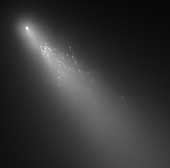 NASA's Hubble Space Telescope is providing astronomers with
extraordinary views of comet 73P/Schwassmann-Wachmann 3, which is
falling apart right before our eyes. Recent Hubble images have uncovered
many more fragments than have been reported by ground-based observers.
These observations provide an unprecedented opportunity to study the
demise of a comet nucleus.
NASA's Hubble Space Telescope is providing astronomers with
extraordinary views of comet 73P/Schwassmann-Wachmann 3, which is
falling apart right before our eyes. Recent Hubble images have uncovered
many more fragments than have been reported by ground-based observers.
These observations provide an unprecedented opportunity to study the
demise of a comet nucleus.
Amateur and professional astronomers around the world have been tracking for years the spectacular disintegration of 73P/Schwassmann-Wachmann 3. As it plunges toward a June 6th swing around the Sun, the comet will pass Earth on May 12th, at a distance of 7.3 million miles, or 30 times the distance between Earth and the Moon.
The comet is currently comprised of a chain of over three dozen separate fragments, named alphabetically, stretching across several degrees on the sky. (The Sun and Moon each have an apparent diameter of about 1/2 of a degree.) Ground-based observers have noted dramatic brightening events associated with some of the fragments (as shown in the bottom frame) indicating that they are continuing to break-up and that some may disappear altogether.
Hubble caught two of the fragments, B and G, (top frames) shortly after large outbursts in activity. Hubble also photographed fragment C (not shown), which was less active. The resulting images reveal that a hierarchical destruction process is taking place, in which fragments are continuing to break into smaller chunks. Several dozen "mini-fragments" are found trailing behind each main fragment, probably associated with the ejection of house-sized chunks of surface material that can only be detected in these very sensitive and high-resolution Hubble images.
Sequential Hubble images of the B fragment, taken a few days apart, suggest that the chunks are pushed down the tail by outgassing from the icy, sunward-facing surfaces of the chunks, much like space-walking astronauts are propelled by their jetpacks. The smaller chunks have the lowest mass, and so are accelerated away from the parent nucleus faster than the larger chunks. Some of the chunks seem to dissipate completely over the course of several days.
Deep-freeze relics of the early solar system, cometary nuclei are porous and fragile mixes of dust and ices. They can be broken apart by gravitational tidal forces when they pass near large bodies (for example, Comet Shoemaker-Levy 9 was torn to pieces when it skirted near Jupiter in 1992, prior to plunging into Jupiter's atmosphere two years later). They can also fly apart from rapid rotation of the nucleus, break apart because of thermal stresses as they pass near the Sun, or explosively pop apart like corks from champagne bottles due to the outburst of trapped volatile gases.
"Catastrophic breakups may be the ultimate fate of most comets," says planetary astronomer Hal Weaver of the Johns Hopkins University Applied Physics Laboratory, who led the team that made the recent Hubble observations and who used Hubble previously to study the fragmentations of comets Shoemaker-Levy 9 in 1993-1994, Hyakutake in 1996, and 1999 S4 (LINEAR) in 2000. Analysis of the new Hubble data, and data taken by other observatories as the comet approaches the Earth and Sun, may reveal which of these breakup mechanisms are contributing to the disintegration of 73P/Schwassmann-Wachmann 3.
German astronomers Arnold Schwassmann and Arno Arthur Wachmann discovered this comet during a photographic search for asteroids in 1930, when the comet passed within 5.8 million miles of the Earth (only 24 times the Earth-Moon distance). The comet orbits the Sun every 5.4 years, but it was not seen again until 1979. The comet was missed again in 1985 but has been observed every return since then.
During the fall of 1995, the comet had a huge outburst in activity and shortly afterwards four separate nuclei were identified and labeled "A", "B", "C", and "D", with "C" being the largest and the presumed principal remnant of the original nucleus. Only the C and B fragments were definitively observed during the next return, possibly because of the poor geometry for the 2000-2001 apparition. The much better observing circumstances during this year's return may be partly responsible for the detection of so many new fragments, but it is also likely that the disintegration of the comet is now accelerating. Whether any of the many fragments will survive the trip around the Sun remains to be seen.
Besides Weaver, the other members of the Hubble observing team are: Carey Lisse (JHU/APL), Philippe Lamy (Laboratoire d'Astronomie Spatiale, France), Imre Toth (Hungarian Academy of Sciences), William Reach (IPAC/Caltech), and Max Mutchler (STScI). Z. Levay (STScI)
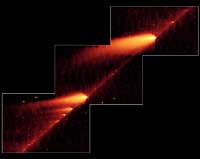 A Million Comet Pieces
A Million Comet Pieces
This infrared image from NASA's Spitzer Space Telescope shows the broken
Comet 73P/Schwassman-Wachmann 3 skimming along a trail of debris left
during its multiple trips around the sun. The flame-like objects are the
comet's fragments and their tails, while the dusty comet trail is the line
bridging the fragments.
Comet 73P /Schwassman-Wachmann 3 began to splinter apart in 1995 during one of its voyages around the sweltering sun. Since then, the comet has continued to disintegrate into dozens of fragments, at least 36 of which can be seen here. Astronomers believe the icy comet cracked due the thermal stress from the sun.
The Spitzer image provides the best look yet at the trail of debris left in the comet's wake after its 1995 breakup. The observatory's infrared eyes were able to see the dusty comet bits and pieces, which are warmed by sunlight and glow at infrared wavelengths. This comet debris ranges in size from pebbles to large boulders. When Earth passes near this rocky trail every year, the comet rubble burns up in our atmosphere, lighting up the sky in meteor showers. In 2022, Earth is expected to cross close to the comet's trail, producing a noticeable meteor shower.
Astronomers are studying the Spitzer image for clues to the comet's
composition and how it fell apart. Like NASA's Deep Impact experiment, in
which a probe smashed into comet Tempel 1, the cracked Comet
73P/Schwassman-Wachmann 3 provides a perfect laboratory for studying the
pristine interior of a comet.
(Courtesy NASA/JPL-Caltech)
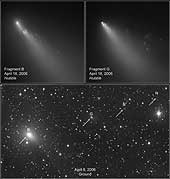 Hubble Provides Spectacular Detail of a Comet's Breakup
Hubble Provides Spectacular Detail of a Comet's Breakup
Hubble Space Telescope is providing astronomers with extraordinary views of
Comet 73P/Schwassmann-Wachmann 3. The fragile comet is rapidly disintegrating
as it approaches the Sun. Hubble images have uncovered many more fragments
than have been reported by ground-based observers. These observations provide
an unprecedented opportunity to study the demise of a comet nucleus. The
comet is currently a chain of over three dozen separate fragments, named
alphabetically, stretching across the sky by several times the angular
diameter of the Moon. Hubble caught two of the fragments (B and G) shortly
after large outbursts in activity. Hubble shows several dozen "mini-comets"
trailing behind each main fragment, probably associated with the ejection of
house-sized chunks of surface material. Deep-freeze relics of the early solar
system, cometary nuclei are porous and fragile mixes of dust and ices that
can break apart due to the thermal, gravitational, and dynamical stresses of
approaching the Sun. Whether any of the many fragments survive the trip
around the Sun remains to be seen in the weeks ahead.
(Courtesy NASA, ESA, JHU/APL, STScI)
 Comet 73P/Schwassmann-Wachmann 3 - Fragment B: Apr. 18, 2006
Comet 73P/Schwassmann-Wachmann 3 - Fragment B: Apr. 18, 2006
Hubble Space Telescope Advanced Camera for Surveys image of Comet 73P/Schwassmann-Wachmann 3 fragment B on April 18, 2006.
(Courtesy NASA, ESA, JHU/APL, STScI)
 Comet 73P/Schwassmann-Wachmann 3 - Fragment B: Apr. 19, 2006
Comet 73P/Schwassmann-Wachmann 3 - Fragment B: Apr. 19, 2006
Hubble Space Telescope Advanced Camera for Surveys image of Comet 73P/Schwassmann-Wachmann 3 fragment B on April 19, 2006.
(Courtesy NASA, ESA, JHU/APL, STScI)
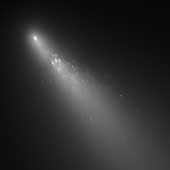 Comet 73P/Schwassmann-Wachmann 3 - Fragment B: Apr. 20, 2006
Comet 73P/Schwassmann-Wachmann 3 - Fragment B: Apr. 20, 2006
Hubble Space Telescope Advanced Camera for Surveys image of Comet 73P/Schwassmann-Wachmann 3 fragment B on April 20, 2006.
(Courtesy NASA, ESA, JHU/APL, STScI)
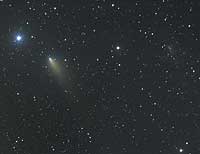 Comet 73P/Schwassmann-Wachmann 3 - Fragments B, G
Comet 73P/Schwassmann-Wachmann 3 - Fragments B, G
Ground-based color composite image of Comet 73P/Schwassmann-Wachmann 3 fragments B and G
on April 21, 2006 made with a 8" f/1.5 Schmidt Camera.
(Courtesy M. Jäger and G. Rhemann)